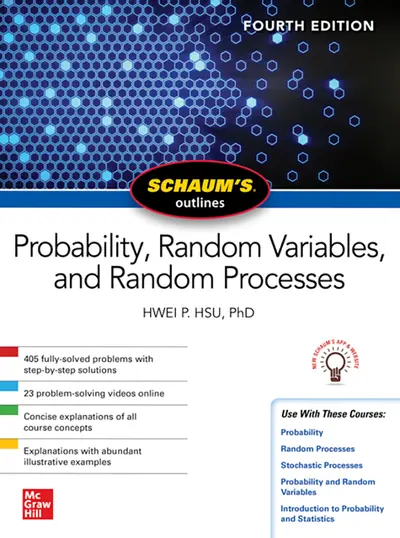My Account Details

ISBN10: 1260453812 | ISBN13: 9781260453812

Step 1 . Download Adobe Digital Editions to your PC or Mac desktop/laptop.
Step 2. Register and authorize your Adobe ID (optional). To access your eBook on multiple devices, first create an Adobe ID at account.adobe.com. Then, open Adobe Digital Editions, go to the Help menu, and select "Authorize Computer" to link your Adobe ID.
Step 3. Open Your eBook. Use Adobe Digital Editions to open the file. If the eBook doesn’t open, contact customer service for assistance.
Publisher's Note: Products purchased from Third Party sellers are not guaranteed by the publisher for quality, authenticity, or access to any online entitlements included with the product.
Tough Test Questions? Missed Lectures? Not Enough Time?
Fortunately, there’s Schaum’s.
More than 40 million students have trusted Schaum’s to help them succeed in the classroom and on exams. Schaum’s is the key to faster learning and higher grades in every subject. Each Outline presents all the essential course information in an easy-to-follow, topic-by-topic format. You also get hundreds of examples, solved problems, and practice exercises to test your skills.
Schaum’s Outline of Probability, Random Variables, and Random Processes, Fourth Edition is packed with hundreds of examples, solved problems, and practice exercises to test your skills. This updated guide approaches the subject in a more concise, ordered manner than most standard texts, which are often filled with extraneous material.
Schaum’s Outline of Probability, Random Variables, and Random Processes, Fourth Edition features:
• 405 fully-solved problems
• 22 problem-solving videos
• An accessible review of probability and statistics concepts
• Clear, concise explanations of probability, random variables, and random processes
• Content supplements the major leading textbooks in probability and statistics
• Content that is appropriate for Probability, Random Processes, Stochastic Processes, Probability and Random Variables, Introduction to Probability and Statistics courses
PLUS: Access to the revised Schaums.com website and new app, containing 22 problem-solving videos, and more.
Schaum’s reinforces the main concepts required in your course and offers hundreds of practice exercises to help you succeed. Use Schaum’s to shorten your study time—and get your best test scores!
Schaum’s Outlines—Problem solved.
Preface to The First Edition
Contents
CHAPTER 1 Probability
1.1 Introduction
1.2 Sample Space and Events
1.3 Algebra of Sets
1.4 Probability Space
1.5 Equally Likely Events
1.6 Conditional Probability
1.7 Total Probability
1.8 Independent Events
Solved Problems
CHAPTER 2 Random Variables
2.1 Introduction
2.2 Random Variables
2.3 Distribution Functions
2.4 Discrete Random Variables and Probability Mass Functions
2.5 Continuous Random Variables and Probability Density Functions
2.6 Mean and Variance
2.7 Some Special Distributions
2.8 Conditional Distributions
Solved Problems
CHAPTER 3 Multiple Random Variables
3.1 Introduction
3.2 Bivariate Random Variables
3.3 Joint Distribution Functions
3.4 Discrete Random Variables—Joint Probability Mass Functions
3.5 Continuous Random Variables—Joint Probability Density Functions
3.6 Conditional Distributions
3.7 Covariance and Correlation Coefficient
3.8 Conditional Means and Conditional Variances
3.9 N-Variate Random Variables
3.10 Special Distributions
Solved Problems
CHAPTER 4 Functions of Random Variables, Expectation, Limit Theorems
4.1 Introduction
4.2 Functions of One Random Variable
4.3 Functions of Two Random Variables
4.4 Functions of n Random Variables
4.5 Expectation
4.6 Probability Generating Functions
4.7 Moment Generating Functions
4.8 Characteristic Functions
4.9 The Laws of Large Numbers and the Central Limit Theorem
Solved Problems
CHAPTER 5 Random Processes
5.1 Introduction
5.2 Random Processes
5.3 Characterization of Random Processes
5.4 Classification of Random Processes
5.5 Discrete-Parameter Markov Chains
5.6 Poisson Processes
5.7 Wiener Processes
5.8 Martingales
Solved Problems
CHAPTER 6 Analysis and Processing of Random Processes
6.1 Introduction
6.2 Continuity, Differentiation, Integration
6.3 Power Spectral Densities
6.4 White Noise
6.5 Response of Linear Systems to Random Inputs
6.6 Fourier Series and Karhunen-Loéve Expansions
6.7 Fourier Transform of Random Processes
Solved Problems
CHAPTER 7 Estimation Theory
7.1 Introduction
7.2 Parameter Estimation
7.3 Properties of Point Estimators
7.4 Maximum-Likelihood Estimation
7.5 Bayes’ Estimation
7.6 Mean Square Estimation
7.7 Linear Mean Square Estimation
Solved Problems
CHAPTER 8 Decision Theory
8.1 Introduction
8.2 Hypothesis Testing
8.3 Decision Tests
Solved Problems
CHAPTER 9 Queueing Theory
9.1 Introduction
9.2 Queueing Systems
9.3 Birth-Death Process
9.4 The M/M/1 Queueing System
9.5 The M/M/s Queueing System
9.6 The M/M/1/K Queueing System
9.7 The M/M/s/K Queueing System
Solved Problems
CHAPTER 10 Information Theory
10.1 Introduction
10.2 Measure of Information
10.3 Discrete Memoryless Channels
10.4 Mutual Information
10.5 Channel Capacity
10.6 Continuous Channel
10.7 Additive White Gaussian Noise Channel
10.8 Source Coding
10.9 Entropy Coding
Solved Problems
APPENDIX A Normal Distribution
APPENDIX B Fourier Transform
B.1 Continuous-Time Fourier Transform
B.2 Discrete-Time Fourier Transform
INDEX
Need support? We're here to help - Get real-world support and resources every step of the way.
